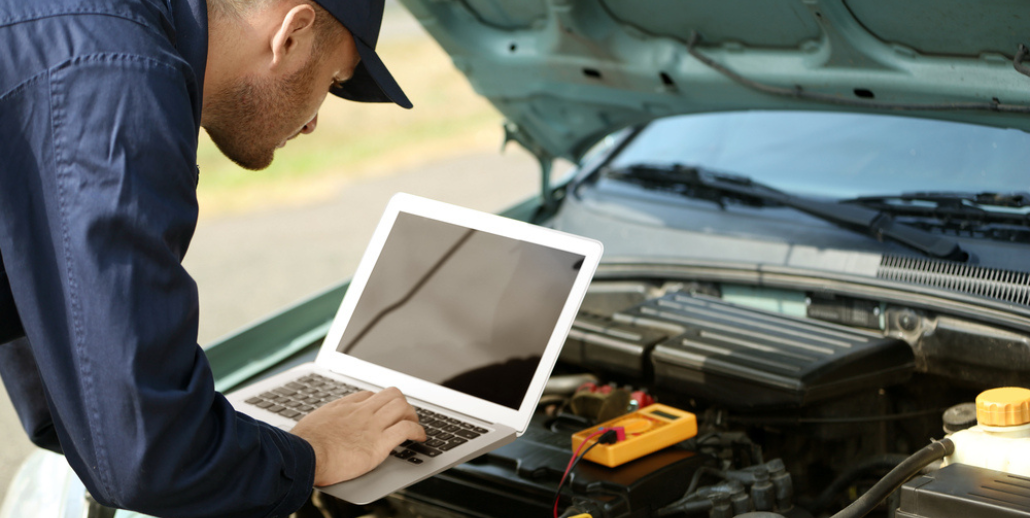When your car has been involved in a collision, the damage will not always be obvious. Some things are extremely obvious (like a busted fender, for instance), but many other problems are less visible. In particular, issues with the vehicle’s electrical systems will not necessarily be plain to see. That is why every good collision repair begins (and ends) with a diagnostic scan.
How Does A Diagnostic Scan Work?
As in the medical field, the term “diagnostics” refers to the process of finding your problems so that they can be fixed. With all the computerization that is present in modern vehicles, a diagnostic scan is highly essential. Otherwise, it can be ridiculously hard to isolate and identify subtle issues.
Diagnostic scans work by using a special tool, technically called an “on-board diagnostic tool.” Yes, the name is highly self-explanatory, but that’s neither here nor there. This is a small device, about the size of a walkie-talkie, that can plug into a special port and scan the vehicle for any known problems. In most vehicles, this port is located under the steering column, but it varies by model.
When the tool is plugged in, it will take a couple of minutes to scan the car’s electronic control modules (ECM). These are small computers that are fed information by special sensors throughout the vehicle. In some cases, it may be necessary to repair one or more sensors and/or ECMs before an accurate diagnosis can be given. The diagnostic tool will display codes that correspond to specific problems.
How Does An ECM Work?
While older vehicles would often have a single ECM, modern vehicles have many. They might be located in the same area, but each of them is technically considered to be a separate computer. Here are the most common types of ECMs that you might find on a vehicle:
- Engine Control Unit- Controls the firing and timing of the engine, while also giving feedback
- Door Control Unit- Controls power doors and gives feedback on their condition
- Power Steering Control Unit- Controls the power steering system and reports any problems
- Powertrain Control Unit- Controls the transfer of force from the engine to the wheels, while also reading any issues
- Body Control Unit- Controls various secondary systems like wipers, air conditioning, etc.
- Transmission Control Unit- Controls the switching of gears in vehicles with automatic transmissions and reports any problems
- ABS Control Unit- Controls the brakes and gives feedback on their performance
- Airbag Control Unit- Controls the deployment of airbags and reads their status
There are others that might be present in your car, but we think you get the idea. Each of these ECMs relies on accurate feedback from their respective sensors, which they use to report codes to a diagnostic tool. Each of these is basically just a small computer that is designed for one specific job.
Pre-Collision Repair Scans and Post-Collision Repair Scans
Whenever you are having a collision repair job done, it is essential to do a pre-repair scan. Otherwise, the repair technician might not fix (or even notice) all of the existing problems. No one wants to pay for half a repair job, so that is not acceptable. Nearly all auto manufacturers recommend that a scan like this should be done before any collision repair. For repairs that are covered under a warranty, it is usually a requirement.
A post-collision scan is just as important. Otherwise, there is no opportunity to verify that the vehicle has been fixed. It will also verify that the mechanic did not create any new problems in the process of fixing the old ones. Some auto manufacturers have gone so far as to require all their certified mechanics to do pre-scans and post-scans on every vehicle of that particular brand.
For instance, GM now requires both of these types of scans whenever a collision has occurred. These guidelines also call for hands-on diagnostic work, but that doesn’t negate the need for scanning.
Can All Vehicles Be Scanned With On-Board Diagnostic Tools?
Unless you are talking about a particularly old vehicle, you should be able to plug in a diagnostic scanner and use it with no problem. EPA regulations mandate that all cars sold after January 1, 1996, must have on-board diagnostic systems so that they will be compatible with such tools. If your car is any older than that, you should probably go to a mechanic who specializes in antique vehicles. These regulations were first introduced in 1994 but did not become fully mandatory until 1996.
How Much Do Repair Shops Charge For Pre/Post Collision Scans?
This will vary somewhat according to the repair shop in question. All mechanics and shops have an hourly labor rate, about which you can ask. Many shops just charge according to the time taken for the scan. Some others, however, charge a flat rate for each scan performed. Talk to your repair shop to find out the specifics of this matter. So, after you ask yourself: “what is the best auto body shop near me?, the next question to answer is: “How much will they charge me for a scan?”
Conclusion
Modern automotive repair is a much more high-tech process than it was in the past. Without proper diagnostic tools, every repair job becomes much more difficult. With these tools, labor costs should be reduced. When the mechanic doesn’t have to take the time to diagnose every problem physically, it creates faster and more efficient service for all. If you would like to know more about this subject, you can call Elmer’s Auto Body at (856) 218-0202. If you need the best South Jersey auto body shop, you cannot go wrong with us.

